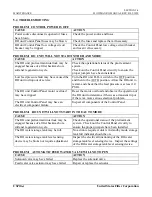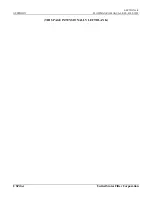
SECTION 5-11
MAINTENANCE
FLOWMAX RO MANUAL REV: B 05/1999
USFilter
United States Filter Corporation
through good pre-treatment filtration practices including, proper selection and operation of
multimedia filtration, the correct selection and maintenance of cartridge filters, and the possible
use of chemicals aimed at dispersion of suspended solids. This type of foulant is generally
evidenced by a
gradual
reduction in the NORMALIZED PRODUCTIVITY RATE with
no
reduction
in the TOTAL DISSOLVED SOLIDS REJECTION RATE.
ORGANIC FOULANTS
Organic fouling of thin film composite membranes is very common and may take place as a
result of two different mechanisms. The first mechanism may be through the presence of organic
material present in the RO UNIT feed water in the form of humic or fulvic acids, which end up
in the water supply as a result of rotting vegetation. Obviously this is more of a problem when
using surface water supplies as opposed to well water supplies.
The second mechanism is the result of actual biological growth taking place on the membrane
surface as a result of the lack of an oxidant in the RO UNIT feed water to kill off these
microorganisms. It is usually impractical to totally eliminate all organic foulants from the RO
UNIT feed water, so all you can do is try to take reasonable precautions through the possible use
of ultraviolet sterilizers on the RO UNIT feed water, conduct good maintenance procedures on
the multimedia filters, including periodic sterilization cycles, and the use of approved biocides
on the RO UNIT MEMBRANE ELEMENTS. This type of foulant is evidenced by a
gradual
reduction
in the NORMALIZED PRODUCTIVITY RATE with either
no reduction
or a
slight
increase
in the TOTAL DISSOLVED SOLIDS REJECTION RATE.
PRECIPITATED DISSOLVED SOLIDS FOULANTS
Precipitated dissolved solids fouling is generally the least common foulant to plague RO UNIT
membranes. This type of fouling generally occurs when the RO UNIT recovery is run too high,
thus concentrating the dissolved solids in the feed water to the last few membranes beyond their
solubility limits. The most common constituents of this type of foulant are Silica (SiO
2
),
Calcium Carbonate (CaCO
3
), Calcium Sulfate (CaSO
4
) and various forms of Iron (Fe) and
Aluminum (Al). Generally this type of fouling is preventable through good administrative
control of RO UNIT recovery, and maintenance of pre-treatment equipment including ion
exchange softeners and antiscalant injection systems. This type of foulant is evidenced by a
gradual reduction in NORMALIZED PRODUCTIVITY RATE with a
minor reduction
in the
TOTAL DISSOLVED SOLIDS REJECTION RATE.
Refer to the manual included with the optional CIP skid for complete cleaning instructions.
(THIS PAGE INTENSIONALLY LEFT BLANK)
























